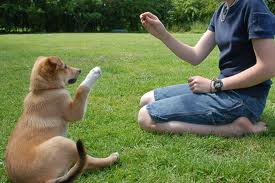How to Teach a Puppy to Give Their Paw? There are many requests from owners to teach tricks to their puppies. Teaching tricks is a very rewarding task for the owner who sees how well his puppy can learn different commands, and the advantages of this learning are many, among which the following stand out:
» You reinforce your leadership role as an owner.
» You encourage the puppy to learn.
» You promote the emotional bond between you and your puppy.
» You stimulate the intelligence of the puppy.
» You are working on obedience with your puppy.
» You ensure that your puppy learns to listen to you in everything you say over time.
How to Teach a Puppy to Give Their Paw?
First, you must be clear that not all puppies learn the same thing. Some puppies learn faster and other puppies that learn slower, but you need to be clear about one thing: your puppy you can teach him just about any obedience trick.
Obedience training sessions for teaching puppy tricks must be kept short. Sessions should not last more than 5 minutes per day. This is because the puppy lacks the attention span humans have. These sessions must be fun for the puppy: the more fun it is, the faster he will learn, so you must control your energy.
I will give you an example of why it can be so important to teach your puppy obedience tricks such as the one we will explain below, paws, or sits, lays down, rolls over, turns around, etc.
These tricks can prevent your dog, for example, from chasing a cat in the park and crossing the street like crazy. With these tricks, you have to say NO to your pup or sit down to keep him in place, avoiding being hit by a car or pushing an older lady by throwing her on the ground.
To teach your puppy a trick, you must be in a quiet room, free of objects and noises that could mislead him.
First, make sure the puppy is sitting. It then uses a single word to command the action: “paw” when you grab its paw and lift it.
You will observe how the puppy has the face of knowing nothing the first few times. It’s normal, he learns. Each time, after saying “paw”, you raise its paw towards you, praise it for the action: use a gentle tone of happiness, sometimes pet it, and sometimes give it some food.
Repeat this action several times in sessions of 5 minutes per day (one session per day). The puppy will learn by associating the action of raising the paw with something very pleasant for him, such as petting, praise or rewards.
Practice this exercise with your puppy, and tell me the results you get.
